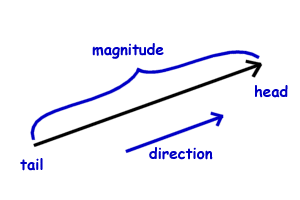Vector Projection Calculator is a step-by-step online calculator that calculates the projection of one vector onto another. It utilizes the standard vector projection formula, and regardless of your math skills, it is pretty easy for everyone. Importantly, our Vector Projection Calculator can be used to find the project of both two-dimensional and three-dimensional vectors. Besides calculating the projection of one vector onto another, our calculator also shows the projection factor.
Additionally, do you want to learn about cross (vector) product? You should check out comprehensive Cross Product Calculator.
What is a vector?
A vector is an object composed of two parts: magnitude and direction. If we look at a vector geometrically, we consider it a straight line with the direction shown by the pointing arrow. The magnitude of the vector is equivalent to the line’s length, whereas the direction is expressed by the point in which the line’s arrow is pointing.

Generally, two vectors are the same if we translate them or change their position without affecting their direction and magnitude. On the opposite, when we have two vectors, and we stretch its tail or head, we can no longer consider those vectors the same. However, regardless of how distant vectors are in the coordinate system, as long as their direction (arrow) and magnitude (line length) remain the same, we consider them as the two equal vectors.
Type of vectors
Considering the magnitude and direction of the vectors, we classify them into six major groups:
Zero or null vector
A zero or null vector is a vector with a magnitude of 0. In other words, the zero vector does not have direction, and its starting point is equal to the ending point.
Unit vector
A unit vector has a magnitude of 1 unit in length. For example, a vector x with the magnitude x is written as x̂.
Position vector
A position vector indicates nothing but a particular point in the plane.
Co-Initial Vectors
A co-initial vector is self-explanatory. Two or more vectors with the same starting point are considered co-initial vectors.
Like and Unlike Vectors
When vectors are pointing in the same direction, we call them like vectors. As opposed to that, when two or more vectors have the opposite direction, we consider them unlike vectors.
Coplanar Vectors
If two vectors lie in the same plane, we consider them coplanar vectors.
Collinear or parallel vectors
If we have two vectors that lie in the plane parallel to each other, we call them collinear or parallel vectors.
Equal Vectors
As long as two vectors have the same magnitude and direction, they are equal vectors regardless of their starting and end points.
Displacement Vector
If a point is displaced from point A to B, AB is considered a displacement vector.
Negative Vector
Suppose we imagine vectors a and b, assumably. In that case, they have the same magnitude but point in the opposite directions – we call them negative vectors. In other words, vector b is the negative of vector a.
Angle Between Two Vectors
If we consider two vectors and their positions in the coordinate system, they relate to each other. Additionally, we can calculate or measure the angle between them using the following formula:
cos \theta = \vec{a}.\vec{b} \div \left| a\right|.\left| b\right|

The angle between two vectors equals the cosine of the angle between them.
Dot Product of Two Vectors
Dot product, or in simpler terms (multiplication of two vectors), is a math calculation that we perform using the formula below:
\vec{a}.\vec{b} = a_{1}b_{1} + a_{2}b_{2} + a_{3}b_{3}
This calculation results in a scalar unit or a number, so we often call dot product the scalar product of two vectors.
Projection of two vectors
The projection of one vector onto another is the product of their magnitudes and the cosecant of the angle between them. For example, suppose vector a projected onto vector b is equivalent to the product of vector a and the cosecant of the angle between vectors a and b. The value we get from the projection is scalar.

It’s important to emphasize that the projection vector has magnitude as a part of the magnitude of vector a. However, the direction of the projection vector is the same as the direction of vector b.
Vector projection formula
Equation for vector projection = P = (a \cdot b \div b \cdot b) \times b!
This is the standard vector projection formula used to calculate the projection of two-dimensional or three-dimensional vectors. Since an orthogonal approach is used in this formula, theoretically, it wouldn’t be incorrect to call it orthogonal projection formula, as well.
Calculate vector projection using our Vector Projection Calculator
Okay, we saw how the vector projection formula works under the hood, but there is an easier way to calculate the projection of two vectors. Instead of calculating it manually, you can use our free step-by-step online vector projection calculator to find the projection of one vector onto another.
You have our calculator in front of you, but it seems complicated or unclear to you? Don’t worry because, in this section, I will explain to you step by step the process of entering the coordinate values of the two vectors and calculating the projection of a vector a onto vector b. So let’s get hands dirty!
Projection of vectors calculator steps:
1) Determine whether you have two-dimensional or three-dimensional vectors
2) Let’s suppose you have two 2D vectors (vector a [2, 8] and vector b [1, 5]
3) Enter the values in the respective calculator fields
4) You can choose to enter values of vectors as coordinates or points (whatever you prefer)
5) Have a look at the scalar result
Projection of a onto b = [1.6154, 8.077]
Projection factor = 1.6154
1.6154 – projection on the x-axis
8.077 – projection on the y-axis
Difference between scalar and vector projection
The difference between scalar and vector projections is in the formula that we use in their calculations. Scalar is a value (number), whereas a vector is not only the number (magnitude) but a composition of the magnitude and direction. Direction is something that differentiates vectors from scalars.
Having this in mind, let’s set the formula for both scalar and vector projections and comment on their differences in approach.

Scalar projection of vector b onto a = (dot product of a & b) \div (length of vector b)
For scalar projections, we first find the dot product of the vectors a & b and then divide that value by the length of the vector b.
Vector projection of vector b onto a = Scalar projection of the vector b \times (Unit vector of a)
For scalar projections, we first find the dot product of the vectors a & b and then divide that value by the length of the vector b.
3D vector projection
A three-dimensional projection of one vector onto another uses the same approach as 2D vectors. However, the only difference is in the number of axis involved. This is because 3D vectors lie in the 3D coordinate system and have x,y,z properties. In the example above, we showed you how to calculate vector projects but of 2D vectors. Therefore, let’s use our step-by-step vector projection calculator again and calculate the vector projection of two 3D vectors.

Vector a [8, -2, 4]
Vector b [2, 6, 1]
Projection of the vector [0.39024, 1.1707, 0.19512]
Projection factor = 0.19512
Real-world applications of vector projection
One of the frequent uses of vector projection we can find in physics for finding the projection of a force in the specified direction. However, civil engineers found it helpful for measuring the strength of materials and structures. Additionally, the Vector projection formula is crucial in spacecraft and aircraft navigation systems.
Basically, anything that includes linear algebra indirectly or directly use the vector projection formula, such as machine learning & data science. Furthermore, software engineers use vector projections when dealing with matrices and their multiplications.
FAQ
What is a vector projection?
When we project a vector onto another, we break it into two component vectors, having one parallel to the second vector and one perpendicular to the second vector.
How to calculate vector projection?
We calculate the projection of one vector onto another by multiplying their magnitudes by the cosecant of the angle between them. In other words, vector projection of vectors a & b is equivalent to the product of vector a and the cosecant of the angle between vectors a and b.
Vector projection formula: P = (a \cdot b \div b \cdot b) \times b!
How to find scalar and vector projections
Scalar projections can be found using the following formula:
Scalar projection of vector b onto a = (dot product of a & b) \div (length of vector b)
Vector projections can be found using the following formula:
Vector projection of vector b onto a = Scalar projection of the vector b \times (Unit vector of a)
